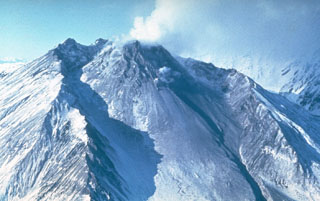Report on Bezymianny (Russia) — 5 April-11 April 2023
Smithsonian Institution / US Geological Survey
Weekly Volcanic Activity Report, 5 April-11 April 2023
Managing Editor: Sally Sennert.
Please cite this report as:
Global Volcanism Program, 2023. Report on Bezymianny (Russia) (Sennert, S, ed.). Weekly Volcanic Activity Report, 5 April-11 April 2023. Smithsonian Institution and US Geological Survey.
Bezymianny
Russia
55.972°N, 160.595°E; summit elev. 2882 m
All times are local (unless otherwise noted)
KVERT reported an ongoing eruption at Bezymianny generally characterized by gas-and-steam emissions and occasional collapses of hot material from the flanks of the summit lava dome. A thermal anomaly over the summit persisted in satellite images during 31 March-6 April. Diffuse ash plumes drifted as far as 550 km E during 2 and 5-6 April. On 6 April volcanologists at the Kamchatka Volcanological Station (KVS) traveled to the Apakhonchich station to assess Bezymianny, take aerial photos, and install monitoring equipment. They observed frequent collapses of the crater rim and ash plumes that drifted NE towards Apakhonchich.
KVERT stated that at 1326 local time on 7 April a satellite image showed an ash plume drifting 150 km E at altitudes of 5.5-6 km (18,000-19,700 ft) a.s.l. A satellite image from 1600 local time that same day showed an ash plume extending as far as 230 km ESE. KVERT noted that ash emissions were intensifying, likely caused by hot avalanches from a growing lava dome. The Aviation Color Code was raised to Red (the highest level on a four-color scale). On 7 April KVS volcanologists traveled to Ambon to collect ash. They reported that a notable eruption began at 1730 local time, and within 20 minutes a large ash plume had risen to 10 km and drifted NW. KVERT reported that the strong explosive phase began at 1738 local time. Based on webcam and satellite data ash plumes rose 10-12 km (32,800-39,400 ft) a.s.l. and drifted SE. Explosions were clearly audible at 20 km distance and were heard for 90 minutes, according to KVS.
Significant amounts of ash fell at the Apakhonchich station, and the snow turned gray. The volcanologists had returned to KVS by the evening, and they were covered in ash. Ashfall continued until the morning of 8 April. In a Volcano Observatory Notice for Aviation (VONA) issued at a 0906 on 8 April, KVERT stated that the strong eruptive phase was over, and the Aviation Color Code was lowered to Orange. Ash plumes had drifted about 2,000 km E. The KVS team saw a lava flow on the active dome once the conditions were clear.
Geological Summary. The modern Bezymianny, much smaller than its massive neighbors Kamen and Kliuchevskoi on the Kamchatka Peninsula, was formed about 4,700 years ago over a late-Pleistocene lava-dome complex and an edifice built about 11,000-7,000 years ago. Three periods of intensified activity have occurred during the past 3,000 years. The latest period, which was preceded by a 1,000-year quiescence, began with the dramatic 1955-56 eruption. This eruption, similar to that of St. Helens in 1980, produced a large open crater that was formed by collapse of the summit and an associated lateral blast. Subsequent episodic but ongoing lava-dome growth, accompanied by intermittent explosive activity and pyroclastic flows, has largely filled the 1956 crater.
Sources: Kamchatkan Volcanic Eruption Response Team (KVERT), Kamchatka Volcanological Station

